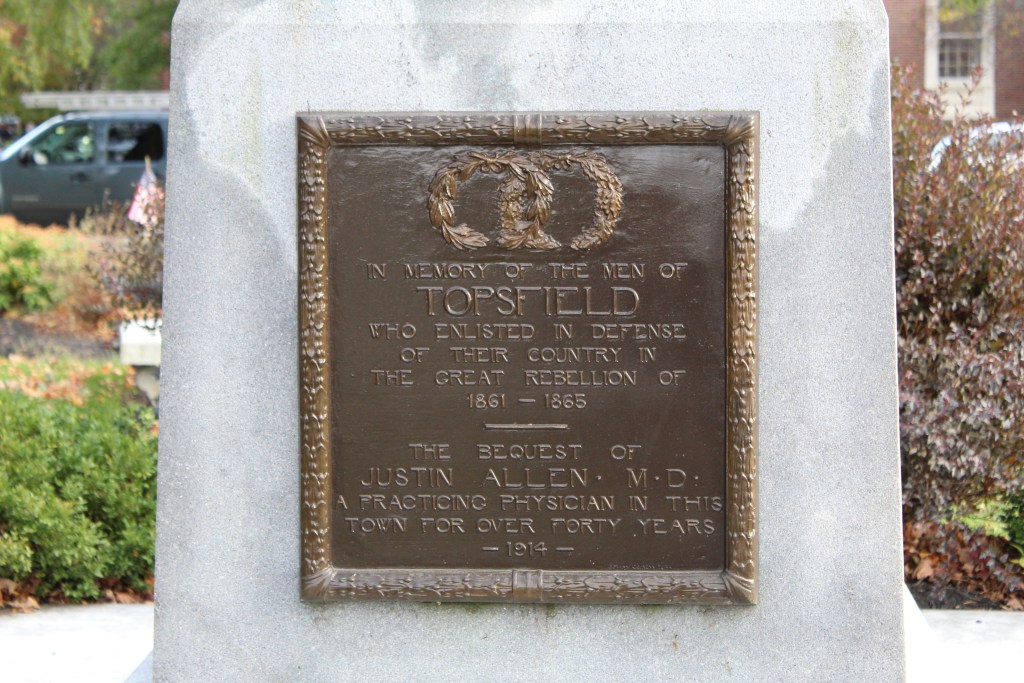

Location: In front of Topsfield Library, 1 South Common Street, Topsfield
Coordinates: 42°38’29.2″N 70°57’00.4″W
Date dedicated: July 25, 1914
Architect/design: Theo Alice Ruggles Kitson, sculptor
Topsfield’s striking monument is titled, “The Wounded Color Sergeant.” It was funded by a gift from Dr. Justin Allen, a physician who had practiced in Topsfield for 40 years and was also president of the local historical society. The primary inscription reads, “In memory of the men of Topsfield who enlisted in defense of their country in the Great Rebellion of 1861 – 1865”.

The statue was sculpted by Theo Alice Ruggles Kitson who was perhaps the most prolific American female sculptor of the early 20th century. Born Theodora Alice Ruggles in 1871, she showed great skill in sculpting from a young age. Her parents sought to enroll her in several prestigious Boston art schools but she was repeatedly denied simply because was a woman. This barrier eventually prompted her use the name “Theo” rather than Theodora. Commissions, she found, could be obtained more easily under the ambiguous name Theo Ruggles Kitson, or sometimes “Tho. A. R. Kitson.” One piece of correspondence from a potential client addressed to “Theobald Kitson” proves the tactic worked.[1]
An up-and-coming young sculptor eventually agreed to train Theo. His name was Henry Hudson Kitson. Born in England in 1863, he came to the United States around 1877. He brought Theo and her mother to Paris in 1887 were she trained for three years under various artists including Pascal. She earned an honorable mention at the Salon des Artistes Francais in 1890—the first woman to do so. In 1893, back in the U.S., she had four works exhibited in the Women’s Building in the Columbian Exposition in Chicago. In 1895, she garnered another first when she became the first woman to be admitted to the National Sculpture Society.[2] Theo married Henry Kitson in 1893. They worked together in a studio in Boston and eventually in Quincy, Massachusetts.
Her first Civil War memorial, known as “The Volunteer,” was sculpted for Newburyport in 1902 and recast for several other locations. That youthful soldier, so full of energy and optimism as he steps off for war, bears a strong resemblance to the central figure in the Topsfield grouping. As one journalist observed upon completion of the statue (but before it was installed), “She has chosen the thin-visaged Yankee, but made him a little older, a little more mature than in some recent soldier boy sculptures.”[3] It almost seems as though Topsfield’s more worn and experienced veteran represents the same “Volunteer” but at the end of the war, in a crowning moment of bravery as he picks up the colors from a fallen color sergeant. When one considers the two statues as part of a narrative, there are certainly parallels to Stephen Crane’s, Red Badge of Courage.
The statue was dedicated during ceremonies on July 25, 1914. Samuel W. McCall gave the oration. He was a longtime U.S. Representative from Winchester and future Governor of Massachusetts. He spoke before a crowd of about 1,000.[4]
132 men from Topsfield served in the Civil War.[5] Of them, 31 died. John Dunlop, a 19 year-old farmer from Topsfield, enlisted with the 12th Massachusetts Infantry in June 1861. That regiment saw tough fighting in many large engagements—particularly at the Battle of Antietam where they suffered the worst casualties of any Federal unit on the field that day. Of the 334 that went into battle, 224 were killed, wounded or missing. Dunlop was one of the wounded during the fighting in the infamous Cornfield. He recovered, was promoted to corporal, then sergeant. In March 1864, he was transferred to the 59th Massachusetts Infantry and promoted to lieutenant. Leading his company during the Battle of the Crater, they became one of the many federal units that advanced too far and were soon surrounded. Lt. Dunlop was killed and buried on the field by Confederates.
Click to enlarge images:
[1] Ethel Mickey, “Memorial artist honored nearly a century later,” Salem News, July 27, 2010.
[2] Jules Heller and Nancy G. Heller eds., North American Women Artists of the Twentieth Century: A Biographical Dictionary, (Routledge Press, 2013), 305.
[3] Boston Herald, February 19, 1914, 9.
[4] Boston Herald, July 26, 1914, 9.
[5] K. David Gross and Emily Marsan, “Topsfield and the Civil War,” a paper delivered at the Topsfield Historical Society, October 26, 2006, 1.





